FASTENERS & JOINING: Joining of Pre-Painted Materials

Manufacturers have had to live with the expensive and cumbersome operations of welding, placement of mechanical fasteners and finishing operations.
With the ever-increasing quest for efficiency by reducing operating expenses and increasing capacity, many of the traditional processes are being re-examined.
The one process that is not only a bottleneck but also one that carries considerable regulatory compliance is the finishing of the product.
By eliminating the need for post-paint operations, the costs of regulatory compliance is reduced, plus manufacturers save the capital burden of the painting facilities in addition to the labor costs associated with handling, cleaning, spraying, and drying operations. By utilizing pre-painted materials, the manufacturer eliminates one of the largest bottlenecks and allows products to hit the market quicker and at a lower manufacturing cost. Additional advantages over the traditional post-painting process are:
4Decrease of work-in-process.
-Decrease in floor space for product inventory.
-Increase in the consistency of the product appearance.
In North America, industries such as major appliances and HVAC, are taking the lead in manufacturing with pre-painted materials.
After the decision to move to pre-painted materials has been made, the next question to answer is, "How can we join our pre-painted materials?"
Mechanical fasteners, adhesives and cold forming methods can join pre-painted materials.
To maximize the benefits of pre-paint the method of joining should not mar the finish or require secondary operations to cover the exposed fastener. With the pre-paint, the use of thermal processing (i.e. spot, resistant, projection and, GMAW welding) is not feasible.
Cold-forming processes (i.e. orbital/radial riveting, staking, and clinching) may destroy the integrity of the coating, and in-turn, may require a secondary process to prevent or inhibit corrosion.
The use of adhesive bonding has gained acceptance over the years. By distributing the load across a larger cross section, an adhesive bond has an advantage of providing a stronger joint, over other traditional joining methods. It also provides a leak-free joint.
A few of the disadvantages of bonding include:
-Many adhesives have an unpleasant odor.
-Possible irritant to the respiratory tract, eyes, and skin.
-May require operators to wear additional personal protection devices.
-Assemblies may need to be cured or stay for extended period of time in fixtures.
-May require an additional fastening method to maintain alignment during curing.
-Surface preparation - additional labor may need to be spent on material prep to allow successful bonding to pre-paint.
-Disposal of the adhesive.
-Clean-up and the containment of spills.
Traditional mechanical fasteners (i.e. bolts, screws, rivets) usually require a pre-drilled or pre-punched hole to insert the fastener. The through-hole is commonly placed during the stamping/forming operation.
The cost associated with the maintenance of the punch and matrix is often over-looked. The down- time or rework caused from a broken punch can also be costly.
Some of the other pitfalls of mechanical fasteners are:
-Fasteners often required skilled operators to ensure the proper torque has been achieved.
-Cross-threading.
-Not always tamper-proof.
-Foreign objects wedge into holes preventing insertion.
One style of mechanical fastening that has an edge over the aforementioned is the AKH FAS-NER SYSTEM®, a simple punch-and-die operation that automatically feeds, punches, inserts and locks a self-piercing FAS-NER® to produce a solid joint all in one operation.
The self-piercing AKH FAS-NER® is inserted directly into pre-painted material without the need for pre-punched holes. This saves the time and labor spent on tooling maintenance and adds flexibility of running multiple applications across the same system.
A few of the advantages are:
-One single action provides the punching, insertion and locking of the FAS-NER®.
-Provides a flush joint.
-Dissimilar materials may be joined together.
-Dissimilar material thickness, and multiple layers can be joined.
-Multiple FAS-NERS® may be installed in a single operation.
-FAS-NER® may be inserted at any angle perpendicular to the surface.
-Eliminates post-process grinding, cleaning and finishing.
-Consistent joint due to less process variables.
-The FAS-NER® can be color matched to the pre-painted ma erial.
-Does not produce harmful fumes and is environmentally safe.
-A clean and quite operation.
AKH Systems range from a single hit machine to completely automated multi-head, multi-hit turnkey systems.
Several product applications at the Trane facility in Cullen, La., are currently being produced using the AKH FAS-NER®, along with pre-painted material.
Commercial size air handlers that in the past were spot-welded and then post-painted are now being produced with the combination of pre-painted material and the painted AKH FAS-NER®.
According to Skipper Martin, manufacturing engineer at Trane's Cullen facility, "We have experienced more consistency in the strength of the joint as well as the appearance. Beyond that, appearance is favorable due to the AKH FAS-NER® being flush with the sheet metal surface and their color has been selected to match that of the pre-painted steel. Also, the process is much more user- friendly and doesn't take years to ‘master the art' as with spot welding."
Since appearance is a huge factor when dealing with pre-painted material, the AKH FAS-NER® can be coated to match the pre-painted materials color along with setting flush with the surface.
Looking for a reprint of this article?
From high-res PDFs to custom plaques, order your copy today!








